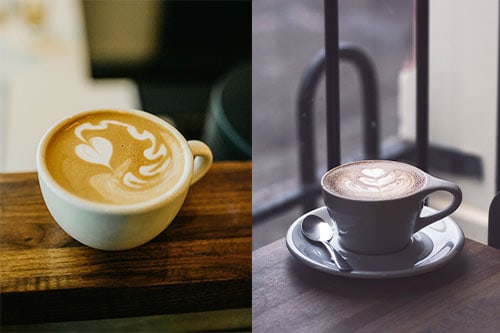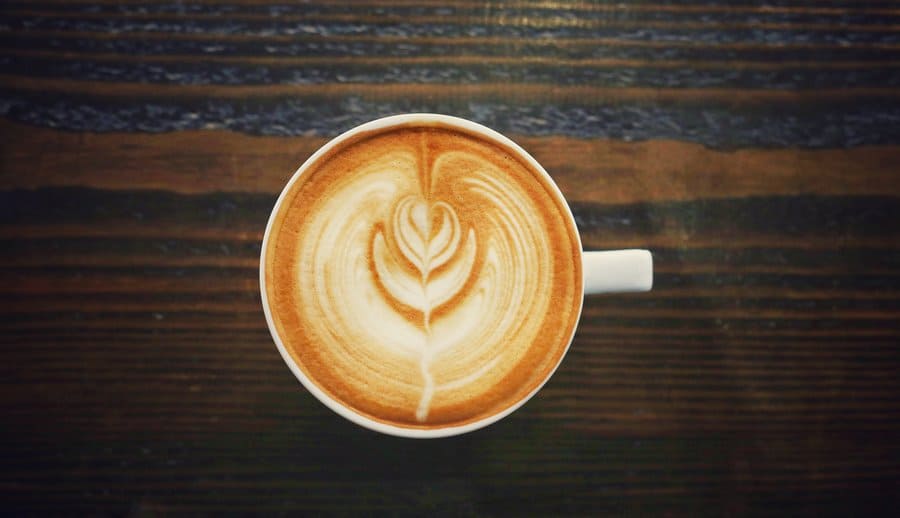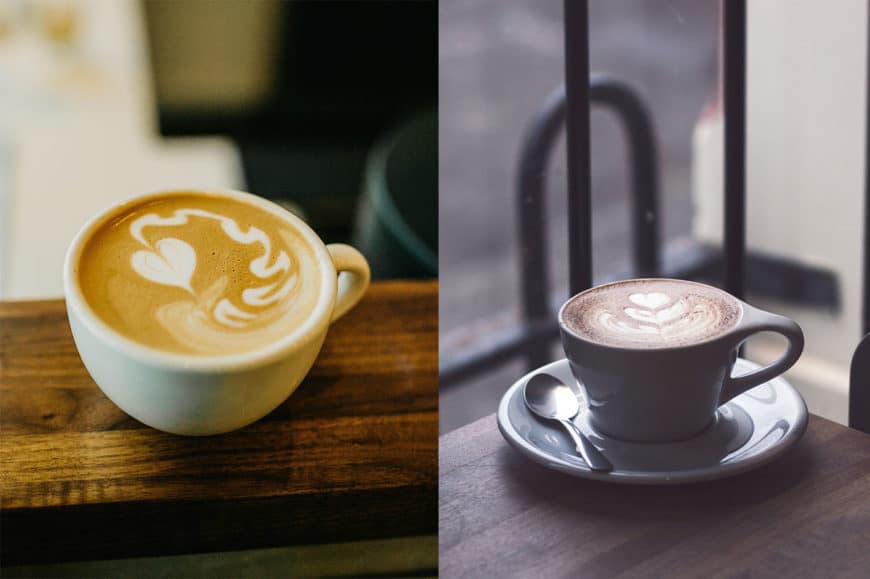
Ever stood at a coffee shop counter, staring at the menu, wondering, “How in the world do you tell the difference between a latte and a cappuccino?” You’re not alone—it’s trickier than it looks! These two espresso-based drinks might seem similar at a glance, but after years of serving both to customers, I’ve cracked the code.
In this guide, I’ll break down everything you need to know to spot the difference, from ingredients to origins, preparation, and even iced versions. Whether you’re a coffee newbie or a seasoned sipper, read on to become a latte vs. cappuccino expert—and maybe even impress your barista next time!
The Key Difference Between a Latte and a Cappuccino
At its core, the difference between a latte and a cappuccino boils down to milk ratios and foam. Both start with espresso, but a latte has more steamed milk and just a thin layer of foam, making it creamier and milder. A cappuccino balances equal parts espresso, steamed milk, and thick foam, giving it a stronger coffee kick and a frothier texture. It’s subtle but significant, and once you know what to look for, you’ll never mix them up again.
It’s subtle but significant, and once you know what to look for, you’ll never mix them up again.
What Is a Latte?
If you’ve ever wondered what makes a latte so popular, it’s all about that smooth, comforting vibe. A latte, short for caffè latte (Italian for “coffee with milk”), is a milky coffee drink that’s become a staple in cafés worldwide. Here’s the breakdown of what goes into it, how it’s served, and why it’s a go-to for so many coffee lovers.
- Ratio: Typically 1/3 espresso (one or two shots) and 2/3 steamed milk, topped with a thin layer of foam (about 1 cm).
- Serving Size: Usually 8-12 ounces, served in a wide, bowl-like cup—perfect for latte art like hearts or rosettes.
- Taste: Creamy and subtle, with the espresso flavor softened by the generous milk.
Lattes are versatile—you can add syrups like vanilla or caramel for a sweeter twist. They’re often served in porcelain or ceramic cups with a saucer for the full experience, though paper to-go cups are common (but less ideal for savoring the texture).
What Is a Cappuccino?
Curious about that frothy drink with a bold personality? A cappuccino is a classic espresso-based coffee that packs a punch despite its smaller size. Here’s what defines it, from its balanced ingredients to its distinctive serving style, and why it’s a favorite for those who love a stronger coffee taste.
- Ratio: Equal parts (1/3 each) espresso, steamed milk, and milk foam—traditionally a 5-6 ounce serving.
- Serving Size: Smaller than a latte, served in a narrow-based cup with a wider rim, often 150-180 ml.
- Taste: Stronger espresso flavor due to less milk, balanced by a thick, airy foam cap.
Traditionally, cappuccinos might get a dusting of cocoa or cinnamon, though modern specialty shops often skip this. Like lattes, porcelain or ceramic cups are best—skip the paper cup to keep that foam intact.
Origins: Where Did These Drinks Come From?
Ever wondered how lattes and cappuccinos got their start? The stories behind these drinks are as rich as their flavors, tracing back through centuries and continents. Let’s dive into their origins to see how history shaped these coffee classics into what we enjoy today.
Latte Origins
The latte’s history is a bit murky, but a popular theory ties it to American coffee culture. In the 1950s, Italian baristas reportedly added extra steamed milk to cappuccinos for U.S. tourists who found the original too strong.
By the 1980s, the latte exploded in Seattle’s coffee scene, boosted by latte art pioneers like David Schomer. The term caffè latte dates back to at least 1867, when William Dean Howells mentioned it in Italian Journeys, though that version was likely closer to a café au lait (brewed coffee and milk).
Cappuccino Origins
The cappuccino’s roots stretch back to 17th-century Vienna, where a drink called Kapuziner—coffee with cream and sugar—mimicked the brown robes of Capuchin friars. The modern espresso-based cappuccino emerged in Italy after the espresso machine’s invention in the early 1900s. By the 1930s, it was a staple, and it hit the U.S. mainstream in the 1980s alongside the latte.
How to Make a Latte
Want to whip up a latte at home that rivals your local café? It’s easier than you might think, and with a few simple steps, you’ll be sipping a creamy masterpiece. Here’s how to make a traditional latte, plus some tips to get it just right.
- Brew Espresso: Pull 1-2 shots (about 1 oz each) using an espresso machine.
- Steam Milk: Heat 4-6 oz of milk (whole milk works best for richness) to 150-160°F, creating a smooth, velvety texture with minimal foam.
- Assemble: Pour the espresso into a wide cup, then add the steamed milk, holding back the foam with a spoon. Top with a thin layer (1 cm) of foam.
- Optional: Add syrup or try latte art if you’re feeling fancy.
Pro Tip: Use a ceramic cup for the best taste and heat retention—paper cups dull the experience.
How to Make a Cappuccino

Ready to master the art of the cappuccino? This frothy favorite takes a little more skill, thanks to that thick foam layer, but it’s worth the effort for a bold coffee treat. Here’s the step-by-step guide to crafting a perfect cappuccino at home.
- Brew Espresso: Pull 1-2 shots (1 oz each).
- Steam Milk: Heat 2-3 oz of milk, but aerate it more to create thick, microfoam—aim for a 1:1 liquid-to-foam ratio.
- Assemble: Pour the espresso into a narrow cup, add the steamed milk, then spoon or pour the foam to fill the top third.
- Optional: Dust with cocoa or cinnamon for a classic touch.
Pro Tip: A smaller, ceramic cup (5-6 oz) keeps the ratios perfect and the foam fluffy.
3 Ways Lattes and Cappuccinos Are Similar
Think lattes and cappuccinos are worlds apart? Not quite—they share more than you might realize. Let’s explore three key similarities that tie these espresso drinks together, despite their distinct personalities.
- Espresso Base: Both use 1-2 shots of espresso. In the U.S., a double shot is standard (about 2 oz), though this varies by shop. I used a medium-dark Brazilian roast with chocolate-nutty notes—ideal for blending with milk.
- Milk Component: Both rely on steamed milk (or alternatives like oat or almond milk). Whole milk is my go-to for its frothing ease and rich flavor.
- Equipment: You’ll need an espresso machine with a steam wand and a frother. No machine? An Aeropress or Moka Pot can mimic espresso, paired with an electric frother for milk.
Bonus: Iced Latte vs. Iced Cappuccino
Hot coffee not your thing on a sweltering day? Iced lattes and cappuccinos bring the same espresso goodness in a chilled form. Here’s how these cold versions differ from their hot counterparts—and from each other—plus a trick to make them extra special.
- Iced Latte: Espresso, cold milk, and ice—no foam or steaming here. It’s smooth and refreshing, with a milder taste.
- Iced Cappuccino: Espresso, a touch of cold milk, and ice, sometimes with a hint of foam if the barista gets creative. It’s bolder than an iced latte.
At my shop, I’d lightly froth milk (barely warm) and pour it over ice with espresso for a creamy twist that bridges the hot and cold worlds. Try it next summer!
Now you know the subtle (and not-so-subtle) differences between a latte and a cappuccino. A latte offers a creamy, milk-forward sip, while a cappuccino delivers a bold, frothy punch. Both are espresso classics with plenty to love, whether you’re sipping at a café or brewing at home.
Next time you’re at your favorite coffee shop, take a closer look—or better yet, try making one yourself! Experiment with milk ratios, cup styles, or even an iced version. Have a preference or a tip to share? Let me know—I’d love to hear your coffee stories!

